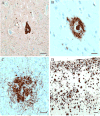Alzheimer disease pathology as a host response
- PMID: 18520771
- PMCID: PMC2763411
- DOI: 10.1097/NEN.0b013e318177eaf4
Alzheimer disease pathology as a host response
Abstract
Identification of amyloid-beta and tau as the major protein components of senile plaques and neurofibrillary tangles, respectively, led to an exponential increase in investigations of these proteins and their corresponding metabolic pathways in Alzheimer disease (AD). The presumptions inherent in most studies and in the dogma of the amyloid cascade concept are that these hallmark lesions in AD brains contain molecules that drive the disease process, and that the proteinaceous accumulations are themselves toxic. On the other hand, the lesions of AD are, by definition, end-stage, and their relationship to the clinical disease is inconsistent; this has long been known but, generally, has not been acknowledged until relatively recently. Some recent attempts to address the etiology and pathogenesis of AD discard the pathology and focus on the interplay between invisible toxic intermediates, that is, amyloid-beta oligomers and the synapse. The concept that the hallmark lesions may be nontoxic (something we have long suggested) is slowly gaining acceptance. We favor the interpretation that senile plaques and neurofibrillary tangles represent a host response to an upstream pathophysiologic process, and that the therapeutic targeting of lesions, including toxic intermediates, will succeed only in the event that the host response is directly deleterious. Therefore, renewed efforts aimed at elucidating fundamental age-related processes such as oxidative stress and/or inflammatory mediators are warranted.
Figures


Similar articles
-
Amyloid-β and tau: the trigger and bullet in Alzheimer disease pathogenesis.JAMA Neurol. 2014 Apr;71(4):505-8. doi: 10.1001/jamaneurol.2013.5847. JAMA Neurol. 2014. PMID: 24493463 Review.
-
Causes versus effects: the increasing complexities of Alzheimer's disease pathogenesis.Expert Rev Neurother. 2010 May;10(5):683-91. doi: 10.1586/ern.10.27. Expert Rev Neurother. 2010. PMID: 20420489 Free PMC article. Review.
-
Aβ-induced acceleration of Alzheimer-related τ-pathology spreading and its association with prion protein.Acta Neuropathol. 2019 Dec;138(6):913-941. doi: 10.1007/s00401-019-02053-5. Epub 2019 Aug 14. Acta Neuropathol. 2019. PMID: 31414210
-
Hypothermia as a risk factor for Alzheimer disease.Handb Clin Neurol. 2018;157:727-735. doi: 10.1016/B978-0-444-64074-1.00044-6. Handb Clin Neurol. 2018. PMID: 30459036 Review.
-
Viewpoint: Crosstalks between neurofibrillary tangles and amyloid plaque formation.Ageing Res Rev. 2013 Jan;12(1):174-81. doi: 10.1016/j.arr.2012.06.002. Epub 2012 Jun 19. Ageing Res Rev. 2013. PMID: 22728532 Review.
Cited by
-
Correlation of Alzheimer disease neuropathologic changes with cognitive status: a review of the literature.J Neuropathol Exp Neurol. 2012 May;71(5):362-81. doi: 10.1097/NEN.0b013e31825018f7. J Neuropathol Exp Neurol. 2012. PMID: 22487856 Free PMC article. Review.
-
Chronic traumatic encephalopathy: A paradigm in search of evidence?Lab Invest. 2015 Jun;95(6):576-84. doi: 10.1038/labinvest.2015.54. Epub 2015 Apr 13. Lab Invest. 2015. PMID: 25867769
-
Immunotherapeutic approaches for Alzheimer's disease.Neuron. 2015 Mar 18;85(6):1162-76. doi: 10.1016/j.neuron.2014.12.064. Neuron. 2015. PMID: 25789753 Free PMC article. Review.
-
A critical appraisal of amyloid-β-targeting therapies for Alzheimer disease.Nat Rev Neurol. 2019 Feb;15(2):73-88. doi: 10.1038/s41582-018-0116-6. Nat Rev Neurol. 2019. PMID: 30610216 Review.
-
Vaccination as a therapeutic approach to Alzheimer's disease.Mt Sinai J Med. 2010 Jan-Feb;77(1):17-31. doi: 10.1002/msj.20156. Mt Sinai J Med. 2010. PMID: 20101719 Free PMC article. Review.
References
-
- Tomlinson BE. Ageing and the dementias. In: Adams JH, Duchen LW, editors. Greenfield’s Neuropathology. London: Oxford University Press; 1992. pp. 1284–410.
-
- Walsh DM, Selkoe DJ. A beta oligomers -a decade of discovery. J Neuro chem. 2007;101:1172–84. - PubMed
-
- Birmingham K, Frantz S. Set back to Alzheimer vaccine studies. Nat Med. 2002;8:199–200. - PubMed
-
- Golde TE. Disease modifying therapy for AD? J Neurochem. 2006;99:689–707. - PubMed
-
- Castellani RJ, Zhu X, Lee HG, et al. Neuropathology and treatment of Alzheimer disease: did we lose the forest for the trees? Expert Rev Neurother. 2007;7:473–85. - PubMed
Publication types
MeSH terms
Substances
Grants and funding
LinkOut - more resources
Full Text Sources
Medical

